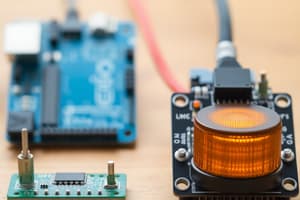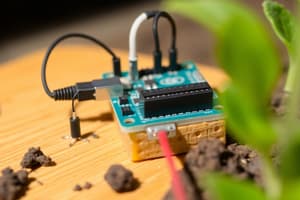Podcast
Questions and Answers
What is the name of the technique used for applying an analog-like signal to a load that has a relatively slow response?
What is the name of the technique used for applying an analog-like signal to a load that has a relatively slow response?
Pulse Width Modulation (PWM)
What is the name of the function in Arduino that is used to write an analog voltage value to an output?
What is the name of the function in Arduino that is used to write an analog voltage value to an output?
analogWrite
What is the name of a commonly available device that can amplify a current?
What is the name of a commonly available device that can amplify a current?
Transistor
What are the two types of motors covered in this chapter?
What are the two types of motors covered in this chapter?
Which of the following are advantages of using a gearhead DC motor?
Which of the following are advantages of using a gearhead DC motor?
Standard hobby servo motors allow for 360 degree rotation.
Standard hobby servo motors allow for 360 degree rotation.
The Arduino board can control a DC motor directly using its digital pins.
The Arduino board can control a DC motor directly using its digital pins.
Analog input pins on the Arduino board can be used as digital input/output pins if not used for analog input.
Analog input pins on the Arduino board can be used as digital input/output pins if not used for analog input.
A separate power supply is recommended for motors, even while powering the Arduino board.
A separate power supply is recommended for motors, even while powering the Arduino board.
What types of sensors are used to detect the presence of an obstacle using ultrasound waves?
What types of sensors are used to detect the presence of an obstacle using ultrasound waves?
What type of sensor is used to detect motion by sensing infrared radiation?
What type of sensor is used to detect motion by sensing infrared radiation?
What is the name of the IR line sensor that is provided in the MEC101 Mechatronics kit?
What is the name of the IR line sensor that is provided in the MEC101 Mechatronics kit?
What is the name of the sensor that senses temperature by producing an analog signal?
What is the name of the sensor that senses temperature by producing an analog signal?
What is the name of the device that changes the direction of power when activated?
What is the name of the device that changes the direction of power when activated?
What type of device is used to change the resistance by changing the effective length of a resistive element?
What type of device is used to change the resistance by changing the effective length of a resistive element?
To control the speed of the motor for the H-bridge, you need to connect the motor logic pins to the Arduino's PWM pins.
To control the speed of the motor for the H-bridge, you need to connect the motor logic pins to the Arduino's PWM pins.
Standard hobby servo motors have an integrated H-bridge circuit.
Standard hobby servo motors have an integrated H-bridge circuit.
Analog line sensors are able to distinguish between different surfaces based on their reflectiveness.
Analog line sensors are able to distinguish between different surfaces based on their reflectiveness.
How does a PIR sensor detect motion?
How does a PIR sensor detect motion?
Flashcards
Switch
Switch
A component used in electronic circuits to allow or block the flow of electrical current.
LED
LED
A type of electrical component that emits light when an electric current flows through it.
Resistor
Resistor
A small electronic component that can be used to control the flow of electricity and usually has a fixed value.
Capacitor
Capacitor
Signup and view all the flashcards
Transistor
Transistor
Signup and view all the flashcards
Diode
Diode
Signup and view all the flashcards
Analog-to-Digital Conversion (ADC)
Analog-to-Digital Conversion (ADC)
Signup and view all the flashcards
Digital-to-Analog Conversion (DAC)
Digital-to-Analog Conversion (DAC)
Signup and view all the flashcards
Momentary Switch
Momentary Switch
Signup and view all the flashcards
Open Circuit
Open Circuit
Signup and view all the flashcards
Closed Circuit
Closed Circuit
Signup and view all the flashcards
Short Circuit
Short Circuit
Signup and view all the flashcards
Output Pin
Output Pin
Signup and view all the flashcards
Input Pin
Input Pin
Signup and view all the flashcards
digitalWrite()
digitalWrite()
Signup and view all the flashcards
digitalRead()
digitalRead()
Signup and view all the flashcards
HIGH
HIGH
Signup and view all the flashcards
LOW
LOW
Signup and view all the flashcards
Pulse Width Modulation (PWM)
Pulse Width Modulation (PWM)
Signup and view all the flashcards
Analog Output
Analog Output
Signup and view all the flashcards
Analog Input
Analog Input
Signup and view all the flashcards
Digital I/O Pin
Digital I/O Pin
Signup and view all the flashcards
DC Motor
DC Motor
Signup and view all the flashcards
Continuous Rotation Servo Motor
Continuous Rotation Servo Motor
Signup and view all the flashcards
Finite Rotation Servo Motor
Finite Rotation Servo Motor
Signup and view all the flashcards
DC Gearhead Motor
DC Gearhead Motor
Signup and view all the flashcards
H-bridge
H-bridge
Signup and view all the flashcards
Photocell
Photocell
Signup and view all the flashcards
Thermistor
Thermistor
Signup and view all the flashcards
Limit Switch
Limit Switch
Signup and view all the flashcards
Ultrasonic Sensor
Ultrasonic Sensor
Signup and view all the flashcards
PIR Motion Sensor
PIR Motion Sensor
Signup and view all the flashcards
Infrared (IR) Line Sensor
Infrared (IR) Line Sensor
Signup and view all the flashcards
Potentiometer
Potentiometer
Signup and view all the flashcards
TMP36 Sensor
TMP36 Sensor
Signup and view all the flashcards
Study Notes
Module 6: Sensing and Actuation with Arduino
-
6.1 Digital and Analog Write and Read with Arduino:
- Includes digital input to control an LED, analog output to control brightness of an LED (PWM), analog input and output to control LED brightness, and using analog input pins as digital I/O pins.
- Uses a resistor in series with a switch for controlling an LED.
- Arduino Uno can read input from switch (HIGH voltage when pressed, LOW when open).
- LED brightness can be controlled with PWM (Pulse-Width Modulation).
-
6.2 DC and Servo Motors:
- Classifies motors as DC, Hobby Servo, Standard DC Gearhead, Stepper, and AC.
- Standard DC/Toy Motors:
- Employ a permanent magnet and commutator.
- Typically rated from 1.5V to 12V and 1000-20000 RPM.
- Often inexpensive.
- Not ideal for high torque applications
- DC Gearhead Motors:
- Standard DC toy motors with reduction gears.
- Significantly lower speed but higher torque.
- Good for Moderate torque applications.
- Standard Hobby Servo Motors:
- DC gearhead motors are precise positioning.
- Limited rotation (typically 0-180 degrees).
- Explains common hobby servo specifications.
-
6.3 DC and Servo Motor Control using Arduino:
-
Controlling DC motors:
- Requires an H-bridge IC (e.g., L293NE or SN754410).
- This device allows for controlling the motor's directions and speeds.
-
Controlling Finite Rotation Servo Motors:
-
Uses Arduino Servo library for easier control.
-
Controlling Continuous Rotation Servo Motors:
-
A similar method to standard servos, but continuous rotation servos have no angle limit.
-
Uses direct control of the motor speed.
-
-
6.4 Interfacing Sensors with Arduino:
- Photocells and Thermistors:
- Photocells change resistance with light intensity (lower resistance with more light).
- Thermistors change resistance with temperature (NTC thermistors decrease resistance with increasing temperature).
- Use a voltage divider circuit to read the sensor values.
- Practical example code is provided to interface and use photocells/thermistors with Arduino.
- Limit Switches:
- Mechanical switches that change connections based on physical force.
- Typical use cases are to detect when something has reached a limit or to halt a movement
- Code is provided for determining the position of the switch and turning an LED on or off.
- Ultrasonic Sensor:
- Uses time-of-flight to measure distances from an object.
- Has a trigger and an echo input pin.
- Common example sensor is the HC-SR04.
- PIR Motion Sensor:
- Detects infrared (IR) radiation changes from moving objects.
- Code example is provided when the sensor detects movement.
- Infrared (IR) Line Sensors:
- Detect lines, usually black lines.
-
Potentiometer:
- Measures rotational position (or angular position) that's linearly proportional to voltage.
- Commonly connect to an analog input on the Arduino.
-
TMP36 Sensor:
-
Senses temperature, producing an analog signal directly proportional to the temperature degrees Celsius.
Studying That Suits You
Use AI to generate personalized quizzes and flashcards to suit your learning preferences.




